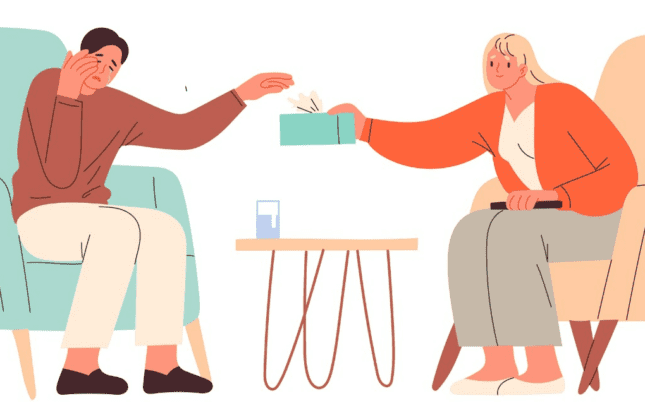When my clients cry in session, I’m never sure whether to pass them a box of tissues. I worry they might interpret it as me trying get them to stop crying or rush through whatever they’re dealing with. Yes or no to passing tissues? And if yes, what do you say, if anything?
A Room Used to Tears
In my office, there’s a big coffee table between the chair where I sit and the couch where my clients usually sit. On the table is a large box of tissues, a notebook and pen, a small calendar, and a few other trinkets.
When my clients begin to cry, they often reach for the box of tissues automatically, or reach into their handbag to get their own. I find clients usually help themselves to tissues as needed. Some will grab a few from the box before they sit down, in anticipation of sharing some tears. Largely, the box sits on the table for them to help themselves.
When clients apologize for crying, as they often do, I respond by telling them, “No need to apologize. This room is used to tears.” Regarding the tissues, I say, “There’s plenty more where that came from.” The point here is to normalize the emotion and tears, and to give an invitation for them to continue crying if it suits them. It also communicates that I’m comfortable with my clients crying.
If a client is crying and not reaching for any tissues, I might suggest—once it looks like a tissue is very much needed—that they help themselves to the tissues on the table. Generally, however, I find clients don’t need an invitation with the box sitting on the table so close to them.
I also regularly check the tissue box to ensure it’s full. I don’t like to run out, if avoidable.
Sally Davis, MNZPsS, MNZCCP
Whakatane, New Zealand
If Tears Could Talk
To tissue or not to tissue—that is the question! My answer is, “Don’t spare the Kleenex!”
It’s no surprise that tears will flow at one point or another in therapy. Most humans feel empathy for others when they begin to cry. The beauty of psychotherapy is creating an environment that feels safe enough to our clients for them to open up and be vulnerable.
I believe that tears, whether from pain or happiness, are a form of communication between the therapist and client. When our clients experience emotion in a session, we should keep in mind that it may be the only time they feel supported enough to experience that emotion.
Because I truly want to establish a positive connection with the other person in the room, I’ll reach for the Kleenex box and offer a tissue to him or her when they begin to cry. Sometimes, the client wipes away his or her tears with their arm and refuses the tissue, which, to me, sends the message that they probably haven’t experienced much caring or trust from others in their life journey.
When the time is right, I use this as an opportunity to discuss with the client why they felt the need to refuse the tissue. My experience has been that positive discussions usually follow, and they’re opportunities for clients to learn more about themselves.
When my clients cry, I also like to ask the question, “If your tears could talk, what would they say?” This has been an excellent way for them to gain more insight and self-awareness.
Tom Pallardy, PsyD, LCPC
Oak Lawn, Il
Giving Permission
Believe it or not, this is a very popular topic in graduate school, as well as in peer consultation groups. Many clinicians ask questions about what to do when clients cry, and just as many have their own ways of handling it.
In my office, I offer easy access to tissues so clients don’t have to move much to grab some. I keep the tissue box in plain sight, in the middle of the table between us, so my clients know exactly where they are on Day One. By having the tissues placed strategically, I don’t usually encounter this quandary. Most of my clients grab their own tissue when needed.
With that said, as a clinician who works primarily with trauma, I sometimes have clients who experience intense emotional releases and can feel embarrassed, overwhelmed, or ashamed of crying, let alone ashamed of crying in front of a clinician. When these clients cry, I let the emotional release happen organically, with minimal intervention from me, and as they wipe their face with their hands, shirt, or sleeve, I’ll gesture softly to the box while warmly saying, “If you want any tissues, please feel free, but you don’t need to use them.”
This does three things: it reminds the client that I’ve witnessed their emotions, that I’m still there supporting them, and that they’re in a safe space with me. This kind of statement can also ground the client back into the room by increasing awareness of things around them. It also gives them verbal permission to take the tissues, as some clients have discomfort using items in the room without explicit permission or suggestion.
Emberleigh Luce, LMFT, CCTP
Groton, CT
Preserving the Client’s Dignity
Many, many years ago, I attended a grief training with an excellent presenter in which this subject was discussed. In the workshop, the presenter challenged all of the therapists in attendance to pay closer attention to what happens when a client is offered a tissue. Afterward, I noticed that every time a tissue was offered to a crying client, either by myself, or a colleague, or an intern, the tears dried up quickly!
Needless to say, for last 25 years, I haven’t offered tissues to crying clients. When the tears have lasted a while and the mucus starts up, I quietly say, “there are tissues over there if you need some” and return the focus to our conversation. I believe that when the client is ready, he or she will reach for a tissue or ask for one. The main reason why I point out the location of the tissues is that it preserves the client’s dignity. I’ve found that many clients get rather embarrassed about mucus and other bodily reactions that accompany tears and emoting.
Over my career, I’ve had the opportunity to supervise over 20 interns, and the topic of when and how to offer tissues has always been a point discussion with each of them. Their reactions to what they observe when a client cries and may need a tissue has resulted in some great insight as they grow their therapeutic skills.
Lana Vsetecka-Schymos, MEd
Colorado Springs, CO
Checking in with Ourselves
Beyond the lighting, books, artwork, and pillows, a survey of my office would find a tissue box on virtually every horizontal surface—not that it’s my goal for clients to plow through them.
The act of handing a tissue sends a message. When I move my body in response to a client’s emotional state, it shows that I see something happening for them. It also shows what’s happening for me as well. Sometimes that can shift my clients into caregiving mode or take them back to a time when someone seeing their emotions was dangerous or made them feel vulnerable, so, throughout sessions, I try to take a moment to pause, breathe, and check in with myself. I may notice tightness or openness, compassion or concern, frustration or impatience, or curiosity or confusion depending on what my expectations for the session or my own day were. Settling my body makes space for the client’s emotions and helps me send a less complicated message back. It allows me to better see how my clients are doing.
Leaning in and offering a tissue might say, “I’m here, you can share what’s happening.” Leaning back or allowing them to get their own might say, “take your time, this isn’t too much for me.” People who are more buttoned-up or cut off from their feelings may never need a tissue, but rather more time, space, and encouragement. Others may be regularly flooded by strong emotions and need help re-regulating.
As the emotional wave passes and their body settles again, we can together notice, explore, clarify, and craft a path forward. We might dig in more or slow down. We can stay focused on what we were discussing earlier, or change course. We can also explore what tears and tissues mean to them. I might say, inside or out loud, “what just happened; that seemed powerful; what was at the heart of that?” Or I might explore what resources the client can tap into.
Noticing and settling my body in relation to my client’s distress is, for me, the most powerful way to decide what to do next and communicate clearly. It also gives me a chance to practice and model tending to emotions and using healthy boundary expression. It’s good for my own emotional wellbeing and good for the relational heart of counseling.
Lori Snyder, LCSW
Ballwin, MO
***
Photo © iStock/undrey
Psychotherapy Networker
The editorial staff of Psychotherapy Networker comprises clinicians, journalists, and writers with a passion for creating a community where therapists gather and grow. Learn more on our About Us page.












